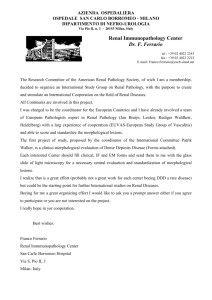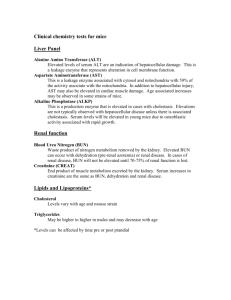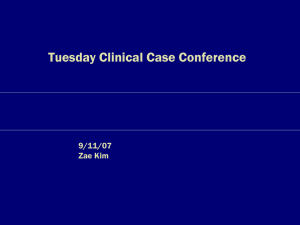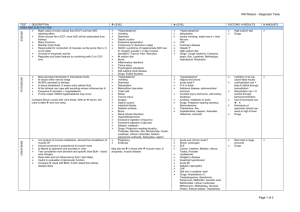Lecture Objectives
advertisement
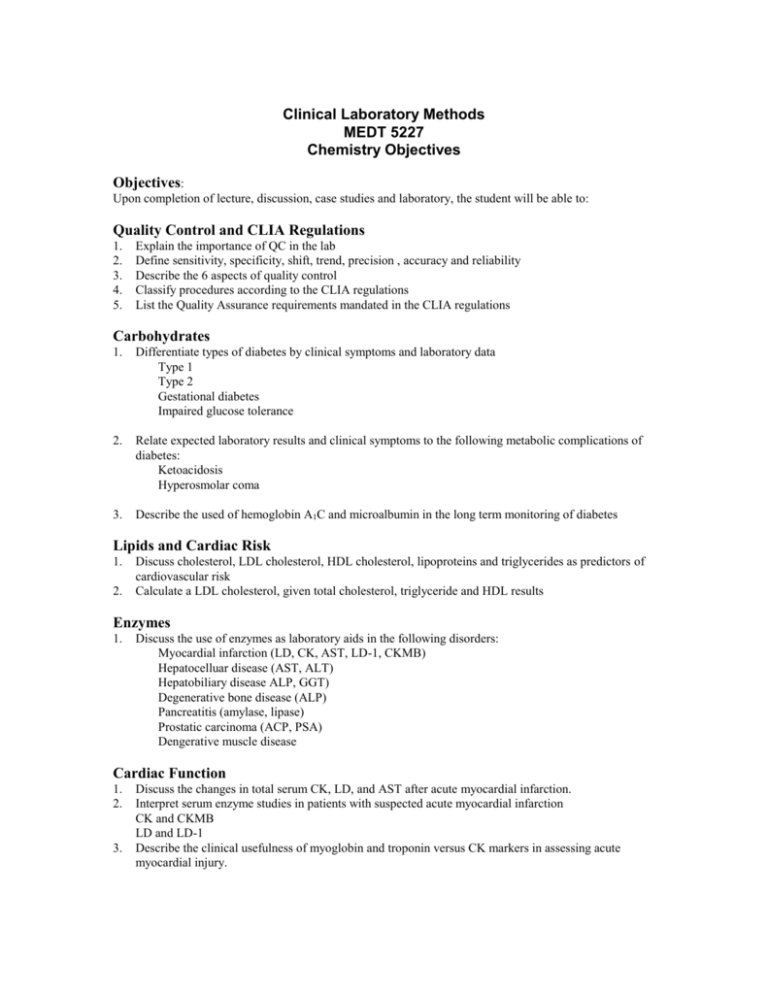
Clinical Laboratory Methods MEDT 5227 Chemistry Objectives Objectives: Upon completion of lecture, discussion, case studies and laboratory, the student will be able to: Quality Control and CLIA Regulations 1. 2. 3. 4. 5. Explain the importance of QC in the lab Define sensitivity, specificity, shift, trend, precision , accuracy and reliability Describe the 6 aspects of quality control Classify procedures according to the CLIA regulations List the Quality Assurance requirements mandated in the CLIA regulations Carbohydrates 1. Differentiate types of diabetes by clinical symptoms and laboratory data Type 1 Type 2 Gestational diabetes Impaired glucose tolerance 2. Relate expected laboratory results and clinical symptoms to the following metabolic complications of diabetes: Ketoacidosis Hyperosmolar coma 3. Describe the used of hemoglobin A1C and microalbumin in the long term monitoring of diabetes Lipids and Cardiac Risk 1. 2. Discuss cholesterol, LDL cholesterol, HDL cholesterol, lipoproteins and triglycerides as predictors of cardiovascular risk Calculate a LDL cholesterol, given total cholesterol, triglyceride and HDL results Enzymes 1. Discuss the use of enzymes as laboratory aids in the following disorders: Myocardial infarction (LD, CK, AST, LD-1, CKMB) Hepatocelluar disease (AST, ALT) Hepatobiliary disease ALP, GGT) Degenerative bone disease (ALP) Pancreatitis (amylase, lipase) Prostatic carcinoma (ACP, PSA) Dengerative muscle disease Cardiac Function 1. 2. 3. Discuss the changes in total serum CK, LD, and AST after acute myocardial infarction. Interpret serum enzyme studies in patients with suspected acute myocardial infarction CK and CKMB LD and LD-1 Describe the clinical usefulness of myoglobin and troponin versus CK markers in assessing acute myocardial injury. Hepatic Function 1. 2. Identify laboratory tests commonly used to diagnose renal disease Correlate expected results in pre-hepatic (hemolytic jaundice), intrahepatic (hepatitis and cirrhosis), and posthepatic (obstructive jaundice) related disorders for the following tests: Serum and urine bilirubin (total, conjugated, unconjugated) Urine and stool urobilinogen Enzymes (AST, ALT, Alkaline Phosphatase, GGT) Renal Function 1. 2. 3. 4. Identify laboratory tests commonly used to diagnose renal disease: BUN (urea) Creatinine Creatinine Clearance Ammonia Discuss the sensitivity and specificity of serum creatinine and BUN as renal function tests. Correlate kidney function tests with clinical findings in: Glomerulonephritis Nephrotic Syndrome Renal tubular acidosis Renal failure - acute and chronic Renal transplants Correlate uric acid values with advanced chronic renal failure and gout. Electrolytes and Acid-base Balance 1. 2. 3. 4. 5. 6. Identify the major electrolytes found in the body and the relative distribution of each. Calculate an anion gap given a set of electrolyte values. Describe the use of a measured and calculated osmolality result. Calculate an osmolality given a set of laboratory results. Identity the normal HCO3/H2CO3, Describe the laboratory parameters (pH, pCO2, and HCO3) for the following acid/base disorders: Respiratory acidosis Respiratory alkalosis Metabolic acidosis Metabolic alkalosis Parathyroid Function and Calcium Metabolism 1. 2. Using PTH and calcium assay results, differentiate between Hypoparathyroidism (primary vs secondary) Hyperparathyrodism (primary vs secondary) Vitamin D levels Correlate serum alkaline phosphatase (ALP) with bone disorders. Thyroid Function 1. 2. Using T3, T4 and TSH levels, differentiate between: Hyperthyroidism (primary, secondary and tertiary) Hypothyroidism (primary, secondary and tertiary) Describe the factors that affect thyroid binding globulin levels. Tumor Markers 1. Explain the value of specific tumor markers for diagnostic and treatment of patients with prostatic cancer (PSA, fecal occult blood) 2. Define the following terms as they relate to tumor markers: diagnostic sensitivity, diagnostic specificity, positive predictive value, negative predictive value







